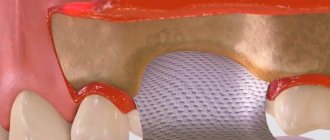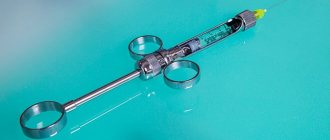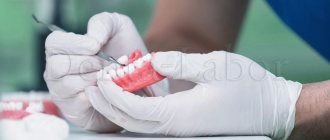The standard idea of prosthetics, as a rule, only covers the installation of an artificial crown that replaces an extracted or fallen tooth and restores the integrity and aesthetics of the row. In the case of implantation, a rod is also added to the number of required elements, replacing the root part and implanted into the structure of the bone tissue. However, few people know that in some dental restorations, one more component can be used – artificial gum, which replaces the missing area of the alveolar ridge.
Functions of artificial gum in implant-supported dentures
In removable dentures, artificial gum is a mandatory element. When the structures are simply fixed on the gums, the artificial gum provides additional fixation because it tightly grips the alveolar ridge.
In the case when the prosthesis is installed on implants, fastening elements are located inside it, just under the gum, on the back side of the dental crowns. Therefore, artificial gum helps to hide them, allowing you to give the dentition a sick aesthetic.
In some cases, doctors insist on adding artificial gum even to permanent dentures . Naturally, this surprises patients. But the gums also play a role, especially with extensive tooth loss or complete edentia. Dental crowns are used to fill the dentition, but artificial gums are used to fill the height of the bite.
This option is applicable for situations where, as a result of a long absence of teeth, your bone tissue has noticeably decreased in volume - the level of the gums, naturally, has fallen. And in order for the dentition to be even, you will have to either build up the bone to the required volume, or choose basal implants that are fixed in the existing bone volume, but then the prosthesis will have a small part of the gum. In addition, if the cause of tooth loss is diseases such as periodontitis or periodontitis, in which the tissues atrophy unevenly, with prosthetics without artificial gums it would be necessary to make crowns that differ significantly in height, which would be completely unsatisfactory from an aesthetic point of view. If bone atrophy is not significant, then the prosthesis is made without artificial gum.
Preparing for surgery
Gingivoplasty requires preliminary preparation of the patient. Before the procedure, the doctor must conduct laboratory tests and studies. For example:
- determination of prothrombin in the blood;
- blood sugar levels;
- HIV test;
- cardiac echocardiography;
- coagulogram.
Depending on the results obtained, additional specialist consultations may be required.
It is better to take an accompanying person with you for the operation itself, as it is performed under anesthesia. Those who have had gum grafting know that applying an ice pack to the injured area is very useful.
Before visiting the hospital, it is not advisable to overeat; it is enough to have a light snack. It is prohibited to drink alcohol a week before the procedure. Clothing must be without a collar.
Classical implantation with bone tissue augmentation
To install implants of a standard classic type, a sufficient amount of bone tissue is required. In this case, you receive a denture without artificial gums, consisting solely of dental crowns. But you will lose in the following:
- the cost of treatment will increase: since the augmentation operation costs some money, besides, classical implantation is almost twice as expensive as the basal method,
- the treatment period will increase: at least three months are needed to restore the bone after augmentation and the same amount more for the complete engraftment of the implants, only after this it will be possible to install a permanent prosthesis
Gum grafting against “gummy” and “shark” smiles
The gingival contour depends on many factors. Genetics, certain medications, and certain diseases lead to soft tissue hypertrophy. There are too many of them, which is why the teeth appear small, the so-called “shark smile” appears. In this case, gingivectomy is used. It consists of excision of excess tissue, elimination of gum pockets or hood, which occurs, for example, during the eruption of “wisdom teeth”. After excision of excess, the desired soft tissue contour is formed.
Many patients also resort to gum grafting, especially on the front teeth, if they have a gummy smile. It is characterized by the exposure of more than two millimeters of the upper gum when a person smiles, which gives the face a “horse” appearance. In this case, with the help of gum plastic surgery, excess soft tissue is removed from the surface of the teeth, and the gum contour is given a beautiful shape.
Expert opinion
Roman Borisovich Alekperov
orthopedic dentist
Experience: 24 years
Although artificial gum helps distribute the load on the jawbone, this distribution is not uniform. This means that over time, atrophic dentures will inevitably develop under the removable denture, the bone will sag, the denture will become uncomfortable, no longer fit, or may even break during chewing. How to prevent the development of bone deficiency? Only with the help of implantation! If you decide to install implants after the tissue has begun to “go away,” take advantage of the possibilities of basal implantation.
What will be obtained as a result
Why is gum grafting done? The doctor’s recommendations for gum augmentation are well founded. The operation contributes to:
- protection of underlying tissues from external factors (food, drink, saliva), from pathogenic microorganisms;
- replenishment of the lack of mucous membrane in the intervention area;
- preventing scar formation;
- prevention of deformation of gingival tissues.
If we look at the aesthetic component of the result, then upon completion of prosthetics, the width of the gum is 3-4 mm, which ensures the most close contact with the surface of the crown.
ROOTT implantation with immediate loading WITHOUT bone tissue augmentation
During ROOTT express implantation, specially designed implants are used, which eliminate the need for bone augmentation. They are fixed in the deepest layer of bone tissue (basal section), which is not subject to atrophy even after several years of missing teeth. As a result, the implants are securely attached and can withstand maximum loads for many decades. But you get a denture with a small piece of artificial gum. But you save in the following:
- the treatment period is reduced: the implants have a solid structure (the tip after installation remains above the gum level) and excellent primary stability, so immediate loading is allowed already 2-3 days after surgery. And due to the usual pressure, bone cells grow as quickly as possible around the installed implant.
- the cost of treatment is reduced: since augmentation surgery is not required, the number of treatment stages is reduced. Due to the reduction in treatment time, the cost is also reduced - when restoring completely lost teeth in two jaws, it is almost two times lower than the classical protocol,
Let us note that today artificial gums are made from modern materials and are matched in shade to the color of natural gums. As a result, the prosthesis is very thin, does not cause discomfort and is completely invisible to others.
Why do my gums hurt after inserting a gum former?
Very often, patients come to the clinic after surgery with a complaint of pain. Should I panic in this case and immediately call a doctor? To answer this question, you need to determine the cause of your anxiety. Before starting the operation, the doctor gives the patient an injection with an anesthetic, so the patient does not feel pain during the entire process. When the anesthesia wears off, pain may occur and continue for several days after implantation. This is quite normal, while the soft tissues are healing and your body is adapting, you may be bothered by this symptom. If the pain does not go away within a week and only intensifies, causing you discomfort, then you should urgently seek help from a doctor. Monitor your condition carefully; some changes may indicate the development of complications. Based on this, we can conclude that if your gums hurt after installing a gum former, then you should not immediately sound the alarm, assess your condition and how long the pain lasts. If complaints arise immediately after the end of anesthesia, then you should wait a few days. The discomfort will either pass or begin to bother you with renewed vigor, in which case you should contact your doctor.
What complications may arise?
Sometimes after gingivoplasty the following may appear:
- severe sensitivity of surrounding tissues;
- the appearance of edema;
- painful sensations.
The listed side effects are easily eliminated or go away on their own as they heal.
Another negative consequence of the operation may be an allergic reaction to the anesthetic. If you are prone to allergies, it is better to notify your doctor in advance and get tested.
- Complete restoration of the dentition in just 4 days!
more detailsRoott Pterygoid Implants Sinus lift is no longer needed!
more details
Once and for life! Express implantation in 4 days with a permanent ReSmile prosthesis
more details
All-on-4, All-on-6, ReSmile, Zygomatic implantation We use all modern methods of dentition restoration
more details
Plastic surgery of soft tissues in the oral cavity: features of the procedure
Before the operation, in our clinic, we first conduct a consultation with the dentist and carefully plan the upcoming procedure. Treatment tactics are always agreed upon with the chief physician. If there is a deficiency of soft tissues, they are built up and their volume is increased using tissue from special donor areas in the oral cavity. And if there is an excess of periodontal tissue, the excess part is removed.
The operation is performed by a periodontist surgeon. He uses local or general anesthesia. It depends on the patient's wishes. During the operation, the edge of the gum is cut closer to the tooth or implant, the surface is cleaned of plaque, food debris, and dental deposits, and work begins with the soft tissue itself.
When performing a local operation, soft tissues are taken from the donor area (on the palate or in the area of the tubercle of the upper jaw) in the oral cavity, their surface is cleaned in a certain way to obtain a true donor graft and applied to the required exposed area.
Doctor's recommendations for care after plastic surgery
Full recovery after surgery takes up to two weeks on average, sometimes more. It all depends on the individual characteristics of the human body, regenerative abilities, and compliance with doctor’s recommendations.
The list of appointments includes the following items:
- taking painkillers and antibacterial drugs as indicated;
- lack of physical activity;
- refusal to visit the bathhouse, sauna;
- eating non-hot food with a semi-liquid consistency;
- exclusion of spicy and sour foods from the diet;
- maintaining careful oral hygiene (carefully brushing your teeth with a soft-bristled brush, avoiding the slightest contact with the stitched area);
- performing mouth rinses;
- wearing a special mouth guard to protect the operated area.
Usually after gingivoplasty there is swelling that goes away within 3-4 days. At first it increases, then gradually decreases. If there is no improvement, you should inform your doctor.











